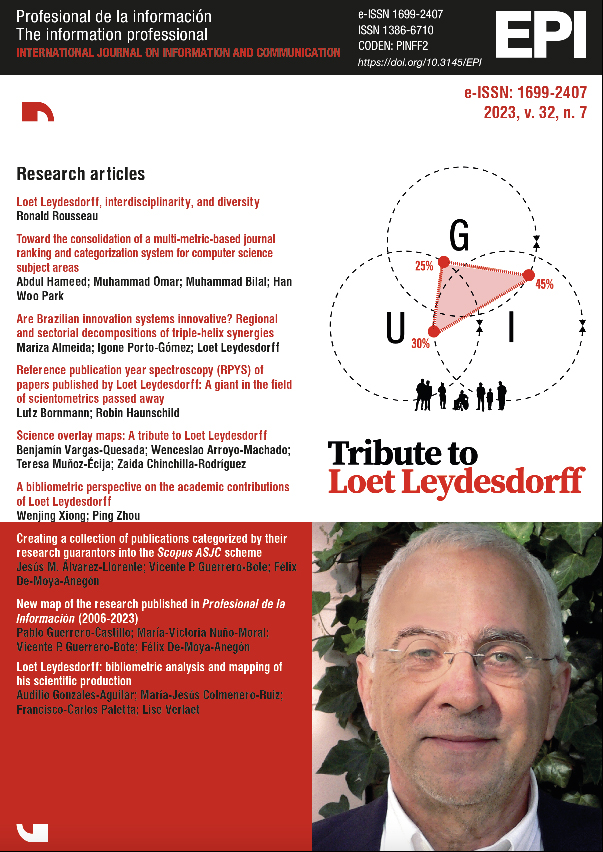Loet Leydesdorff, interdisciplinarity, and diversity
DOI:
https://doi.org/10.3145/epi.2023.dic.02Palabras clave:
Evenness profiles, Diversity, Gini index, Interdisciplinarity, Bibliometrics, Indicators, Science of science, Loet LeydesdorffResumen
Diversity, as used in interdisciplinarity studies, has three components: variety, evenness, and dissimilarity. In 2019, Leydesdorff, Wagner, and Bornmann proposed an indicator, denoted DIV*, that independently operationalized these three components and then combined them. Gini evenness is one factor in this formula. An important point is that Leydesdorff and his colleagues rejected so-called dual concepts, i.e. concepts that mix or are influenced by at least two of the three basic components of diversity. A few years ago Chao and Ricotta took a new look at "evenness" and showed that the Gini evenness measure, as well as the Lorenz curve, are dual concepts as they are influenced by variety. For this reason, I propose to replace the Gini evenness measure in DIV* with an evenness measure, actually an evenness profile, that is not influenced by variety.
Descargas
Citas
Abramo, Giovanni; D’Angelo, Ciriaco A.; Zhang, Lin (2018). “A comparison of two approaches for measuring interdisciplinary research output: The disciplinary diversity of authors vs. the disciplinary diversity of the reference list”. Journal of informetrics, v. 12, n. 4, pp. 1182-1193. https://doi.org/10.1016/j.joi.2018.09.001
Chao, Anne; Ricotta, Carlo (2019). “Quantifying evenness and linking it to diversity, beta diversity, and similarity”. Ecology, v. 100, n. 12, pp. article e02852. https://doi.org/10.1002/ecy.2852
Dalton, Hugh (1920). “The measurement of the inequality of incomes”. The economic journal, v. 30, n. 119, pp. 348-361. https://doi.org/10.2307/2223525
Egghe, Leo; Rousseau, Ronald (1990). “Elements of concentration theory”. In: Egghe & Rousseau (eds.). Informetrics 89/90, pp. 97-137. Amsterdam: Elsevier.
Jost, Lou (2009). “Mismeasuring biological diversity: Response to Hoffmann and Hoffmann (2008)”. Ecological economics, v. 68, n. 4, pp. 925-928. https://doi.org/10.1016/j.ecolecon.2008.10.015
Jost, Lou (2010). “The relation between evenness and diversity”. Diversity, v. 2, pp. 207-232. https://doi.org/10.3390/d2020207
Kvålseth, Tarald O. (1991). “Note on biological diversity, evenness, and homogeneity”. Oikos, v. 62, pp. 123-127. https://doi.org/10.2307/3545460
Leinster, Tom; Cobbold, Christina A. (2012). “Measuring diversity: The importance of species similarity”. Ecology, v. 93, n. 3, pp. 477-489. https://doi.org/10.1890/10-2402.1
Leydesdorff, Loet; Wagner, Caroline S.; Bornmann, Lutz (2019a). “Interdisciplinarity as diversity in citation patterns among journals: Rao-Stirling diversity, relative variety, and the Gini coefficient”. Journal of informetrics, v. 13, n. 3, pp. 255-269. https://doi.org/10.1016/j.joi.2018.12.006
Leydesdorff, Loet; Wagner, Caroline S.; Bornmann, Lutz (2019b). “Diversity measurement: Steps towards the measurement of interdisciplinarity?”. Journal of informetrics, v. 13, n. 3, pp. 904-905. https://doi.org/10.1016/j.joi.2019.03.016
Nijssen, David; Rousseau, Ronald; Van Hecke, Piet (1998). “The Lorenz curve: A graphical representation of evenness”. Coenoses, v. 13, n. 1, pp. 33-38. https://www.jstor.org/stable/43461212
Pratt, Allan D. (1977). “A measure of class concentration in bibliometrics”. Journal of the American Society for Information Science, v. 28, n. 5, pp. 285-292. https://doi.org/10.1002/asi.4630280508
Ràfols, Ismael (2014). “Knowledge integration and diffusion: measures and mapping of diversity and coherence”. In: Measuring scholarly impact. methods and practice. Ding, Ying; Rousseau, Ronald; Wolfram, Dietmar (eds.). Cham: Springer, pp. 169-190. ISBN: 978 3 319 10377 8 https://doi.org/10.1007/978-3-319-10377-8
Ràfols, Ismael; Meyer, Martin (2010). “Diversity and network coherence as indicators of interdisciplinarity: Case studies in bionanoscience”. Scientometrics, v. 82, n. 2, pp. 263-287. https://doi.org/10.1007/s11192-009-0041-y
Rousseau, Ronald (2018). “The repeat rate: From Hirschman to Stirling”. Scientometrics, v. 116, n. 1, pp. 645-653. https://doi.org/10.1007/s11192-018-2724-8
Rousseau, Ronald (2019). “On the Leydesdorff-Wagner-Bornmann proposal for diversity measurement”. Journal of informetrics, v. 13, n. 3, pp. 906-907. https://doi.org/10.1016/j.joi.2019.03.015
Rousseau, Ronald; Zhang, Lin; Hu, Xiaojun (2019). “Knowledge integration: its meaning and measurement”. In: Springer handbook of science and technology indicators. W. Glänzel; H. F. Moed; U. Schmoch; M. Thelwall (eds.), pp. 69-94. https://doi.org/10.1007/978-3-030-02511-3_3
Stirling, Andy (2007). “A general framework for analysing diversity in science, technology and society”. Journal of the Royal Society Interface, v. 4, n. 15, pp. 707-719. https://doi.org/10.1098/rsif.2007.0213
Taillie, C. (1979). “Species equitability: a comparative approach”. In: Grassle, Patil, Smith & Taillie (eds.). Ecological diversity in theory and practice. Fairland (MD): International Co-operative Publishing House, pp. 51-62. ISBN: 978 0 899740034
Zhang, Lin; Rousseau, Ronald; Glänzel, Wolfgang (2016). “Diversity of references as an indicator for interdisciplinarity of journals: Taking similarity between subject fields into account”. Journal of the Association for Information Science and Technology, v. 67, n. 5, pp. 1257-1265. https://doi.org/10.1002/asi.23487
Descargas
Publicado
Cómo citar
Número
Sección
Licencia
Derechos de autor 2023 Profesional de la información

Esta obra está bajo una licencia internacional Creative Commons Atribución 4.0.
Condiciones de difusión de los artículos una vez son publicados
Los autores pueden publicitar libremente sus artículos en webs, redes sociales y repositorios
Deberán respetarse sin embargo, las siguientes condiciones:
- Solo deberá hacerse pública la versión editorial. Rogamos que no se publiquen preprints, postprints o pruebas de imprenta.
- Junto con esa copia ha de incluirse una mención específica de la publicación en la que ha aparecido el texto, añadiendo además un enlace clicable a la URL: http://revista.profesionaldelainformacion.com
La revista Profesional de la información ofrece los artículos en acceso abierto con una licencia Creative Commons BY.




